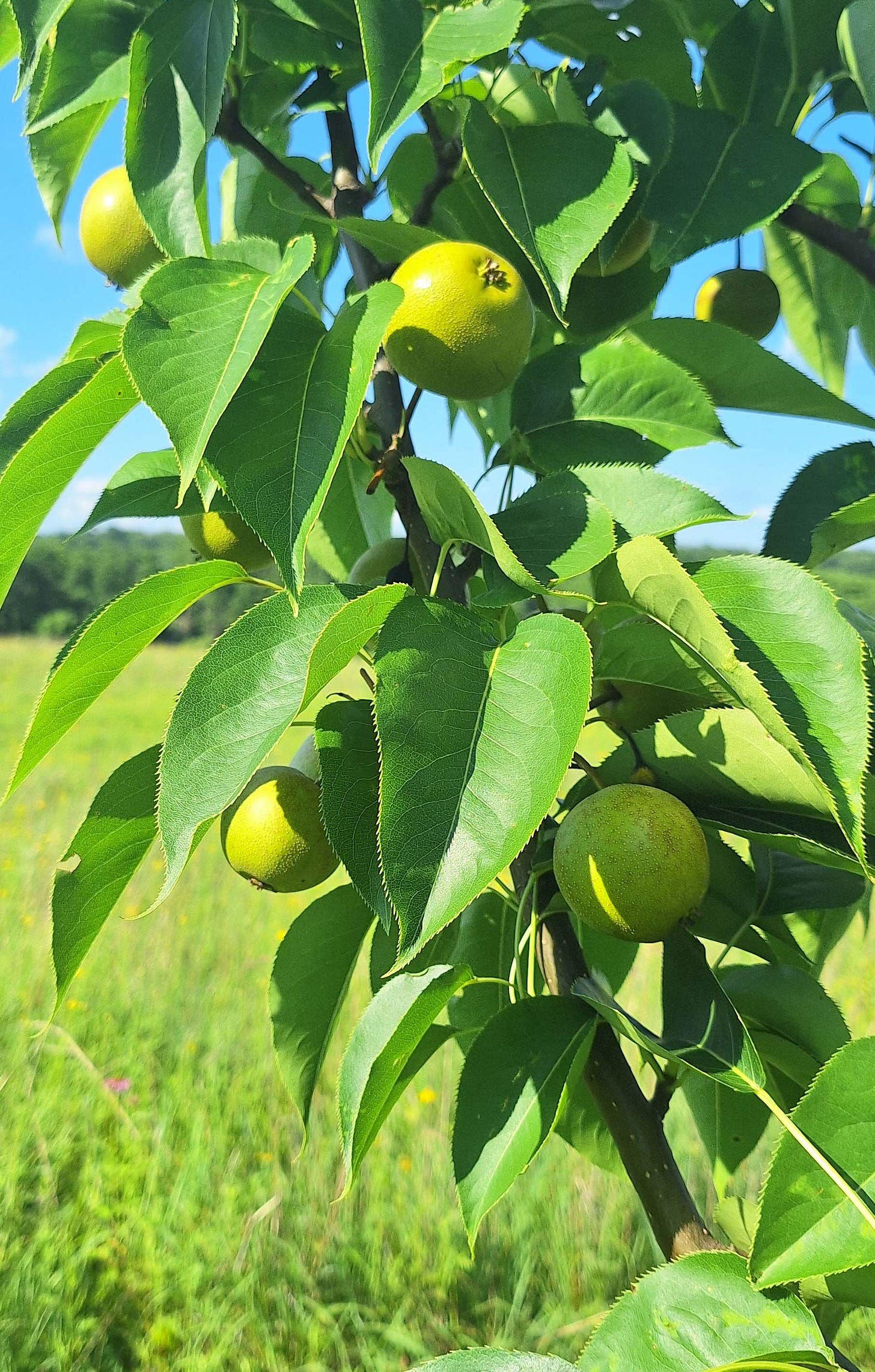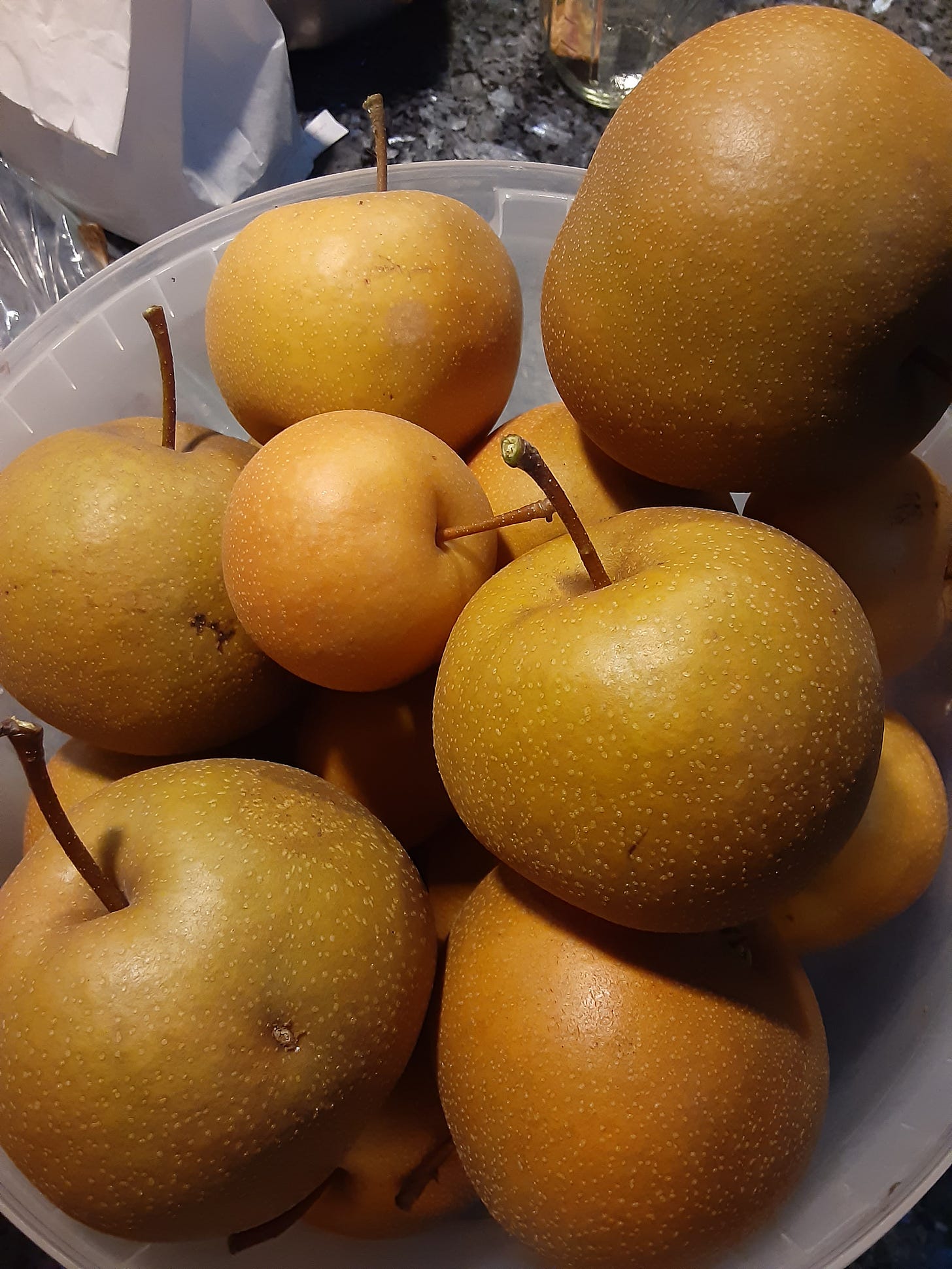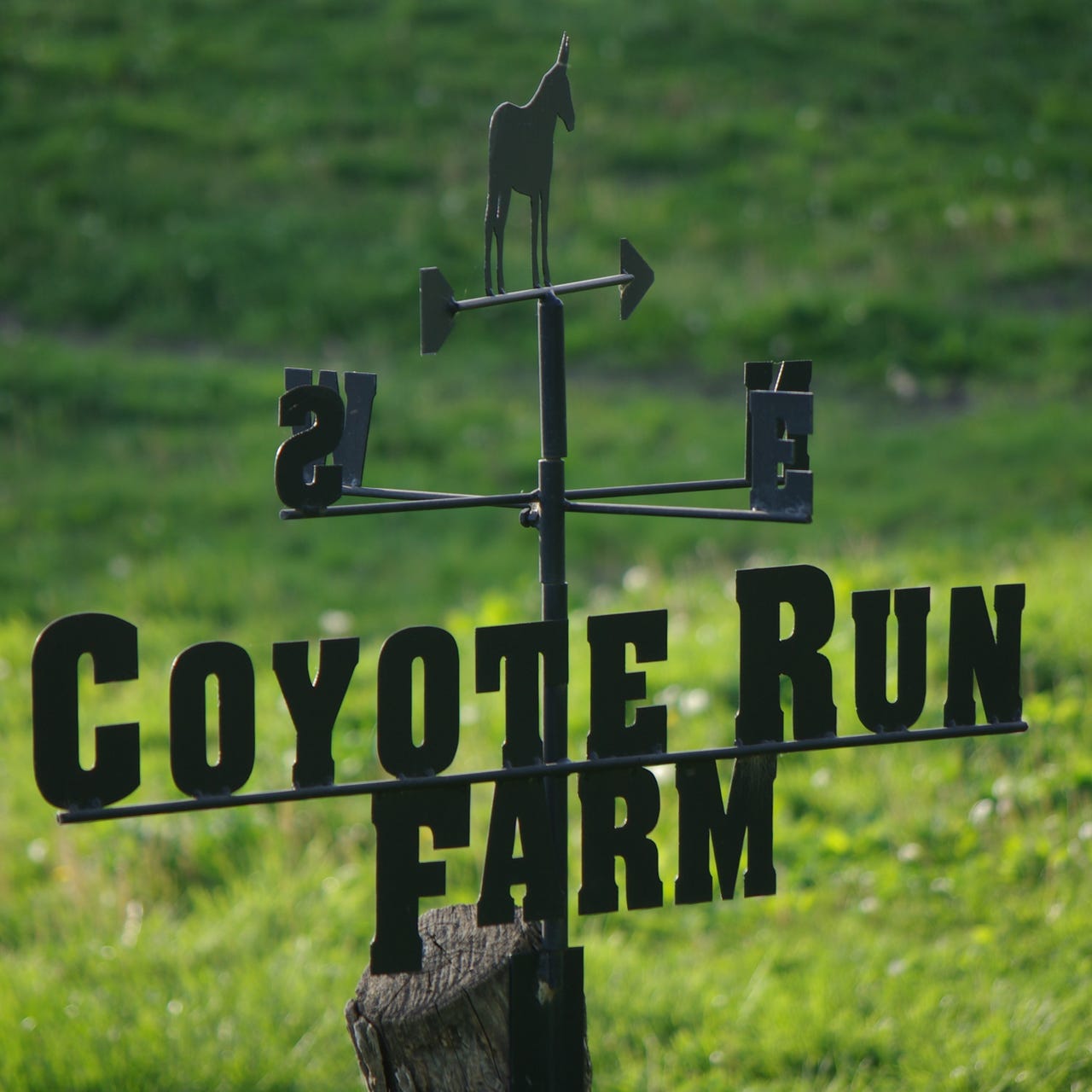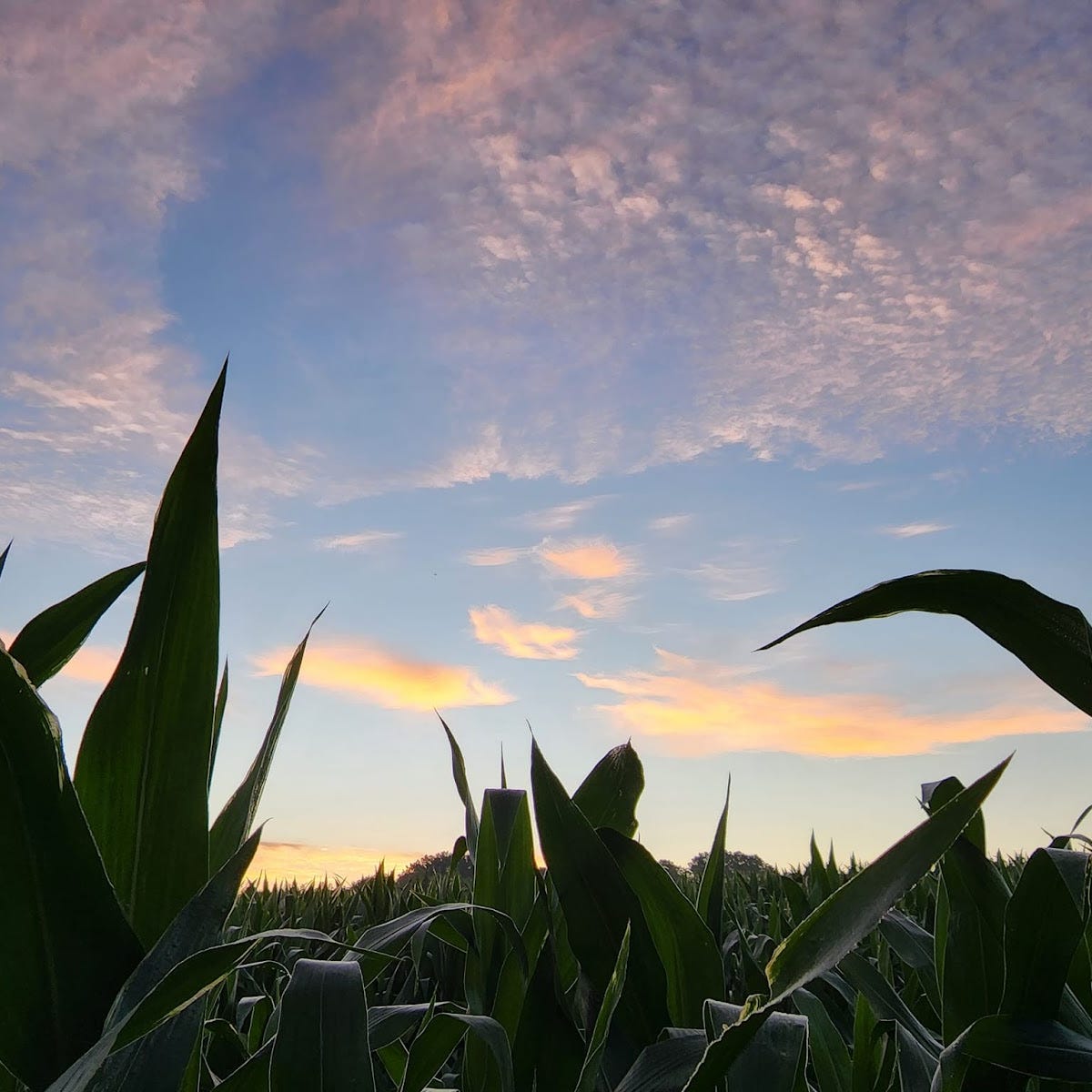As a Postcards reader you get an early-bird special on farm-fresh Asian pears. See below and thank you for reading.
I’ve planted 75 Asian pear trees over the last 9 years. For about half their lives, they were neglected due to my off-farm work. Those years, I gave away the fruit that survived my neglect.
But I’ve been back tending them. Now I’ve got 700 pears ripening on those trees! Even with anticipated loss to wasps and ants (they LOVE them), I’ll still have plenty to sell.
But I don’t know where to sell them. And I resent that.
I did my research up front. I planted high value specialty crops. Superior taste, long shelf-life (for fruit), high disease and pest resistance, easy transport. In the lead-up to this day, I built a Draco Hill Nature Farm model of free events all year long. I’ve given away lots of free samples to farm visitors.
This is where the rubber hits the gravel. I’ve got about a month to find my market.
Truth is, no farmer should have to be a pro at growing plus marketing, selling and distributing. Yet a lot of new Millennial and Gen Z veggie farmers are doing all of that, every year, with a lot fewer resources and a lot more crops than I have. It’s not sustainable.
Did “the market” decide this?
No. The government did.
“There is no market for local food in Iowa,” an Iowa State University ag lackey once told me. What he meant was, “You can’t auger it onto a truck and haul it off to god-knows-where to be processed into diapers and ethanol.”
Well, there’s a reason for that.
Count the billions in federal subsidies that go to farmers to grow commodities.
Add the billions poured into land grant institutions like Iowa State to research, develop and engineer better machinery and systems for those commodities.
Throw in the billions major corporations pay for PhDs and infrastructure at those schools to further the profitability of those commodities.
Can you see the fat guy in a top hat with a cigar sitting on $$ bags?
Oh wait! Here comes the pauper begging for a dime. We must be back in the Golden Age like our president promised!
Last year, Iowa dedicated a measly $200,000 to its “Choose Iowa” program to promote local foods. That’s like spitting in a toxic Iowa river and serving it up as craft beer. It’s an insult.
It’s also a function of power. Power we food farmers no longer have.
I had hoped the next generation would rebuild our local and regional food system. We’d grow a critical mass of local food farms. There would be enough business to spawn new businesses in truck driving and graphic design, marketing and sales. Agritourism on some farms would help reinvigorate small towns with the new traffic passing through. Maybe they’d have more than a Casey’s making money on Main Street.
For about a minute, I could see it. Because about 5 years ago, I watched a guy named Matt Russell put it over the political top.
The last time Iowa had a first-in-nation caucus that mattered, Matt’s farm was a dedicated stop for every Democratic candidate. His connection to Iowa journalist Bob Leonard got him on the presidential radar with an OpEd in the New York Times. His small, diversified farm and his policy background allowed him to illustrate the value of good local and regional food policy.
Everything builds on everything else, of course. Local food research funded by the Leopold Center for Sustainable Agriculture in the early 2010’s built local food and sustainable ag infrastructure throughout the state. The center was a model for others around the country.
Without the Leopold Center, there would be no local food or sustainable farming infrastructure in Iowa at all. Republicans chowing down at the Big Ag trough knew that. So they killed it.
But Matt’s impact was obvious. USDA emails under Biden contained this statement: “The Biden-Harris administration is committed to rebuilding local and regional food systems.” And it was!
For a few short years, real money poured into local foods and climate-smart ag across the nation. Entrepreneurs built value-added businesses to sell jams, cured meats or dried herbs, small farmers expanded their infrastructure, building on-farm kitchens and community venues. They marketed their goods more widely. They saw a future in market farming.
Nonprofits received millions to provide technical support to farmers, hosting field days and doing research that Iowa State wouldn’t, couldn’t or would take 49% off the top of every grant for. Groups could pursue questions the Farm Bureau - politically and financially invested in commodities and their associated chemical companies - wouldn’t touch with a barge pole. What’s the most profitable lettuce? How to build an affordable walk-in cooler. Protecting your fruit trees from pests.
Everyone was riding the tide of the local food movement, as they liked to call it. (By definition, a movement isn’t government-funded. A story for another day.)
The local food system began to revive after 4 decades of atrophy. Consumers and farmers started finding each other. Planning and development staff began to see the benefits of these small farms near their communities.
The government had begun investing enough to rebuild the market.
And just as it was gaining steam, Trump pulled the plug. In Iowa, that meant $11 million gone this Spring. That comes to nearly $4,800 per specialty crop farmer in Iowa this year. Poof! For some, that’s the difference between a farm that survives and one that dies.
Me? I’m going to have to invest in a $300 commercial scale. Another outlay before knowing if I’ll sell a single pear. Most beginning farmers couldn’t scrape that or the other upfront costs together for perennial food farming, so they wouldn’t go into it in the first place. Even if it holds soil and sequesters carbon. Even if it’s freshness means more nutritional value and flavor. So yep, even if it’s good for you and the planet.
Without the government support other ag gets, it just doesn’t pencil out.
I’m too old to start shilling at farmers markets. I’ll call fellow farmers to see if they’d like to trade sales for customer access. I’ll chat up a few local grocers and see about doing some tastings. I’ll contact what’s left of our local food hub and see if they will buy some. And I’ll ask you below.
In other words, I will humbly try to catch the end of the wave that was a government-supported local foods “market” before it’s gone.
Or, I could just sell them all to you!
Early-bird orders taken here
5 Asian pears for $15 and 10 for $25. Some varieties are the size of apples (the one in the center) and are almost as sweet as caramel apples and some are twice the size (the ones at the top right and lower left) and so juicy you’ll never forget the party in your mouth. I’ll offer a variety as they ripen.
Pick up at the farm or a location we agree on in Iowa City or West Branch! Tag your purchase in Venmo so I know it’s for pears, and include contact info. I’ll let you know when they’re ready!
I am a proud member of the Iowa Farmers Union. Join here as a farmer or friend of family farmer. Members-only Barn Party July 26th, 4-7 pm in Elkhart, IA, honoring Neal Flora and celebrating independent family farms.
You can find Matt Russell and Bob Leonard on Substack here - Tell them I sent ya!
At Draco Hill this month
Evening Farm Stroll Friday, July 18, 6 pm. Free samples, photo ops, prairie talk, orchard walk. Sign up here. It’s FREE.
Saturdays July 12 and 19 are still available for group outings. Hikes, prairie walks, fishing (with a license), foraging. Free access to more than 4 miles of hilly trails. Contact me through the Draco Hill contact form.
UUS Land Ministry committee visits this Wednesday! This impressive group of land stewards tend to the 8+ acres the Unitarians own and worship on in Coralville.










xy4a(*
If there are any CSAs near you, it might be worth asking if they would be interested in having them as an add-on to their weekly boxes while the pears are in season.